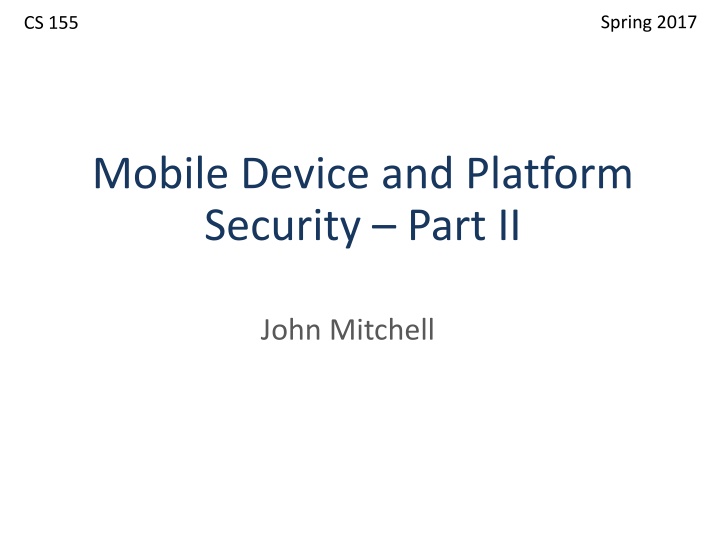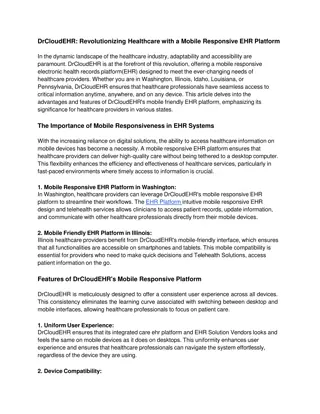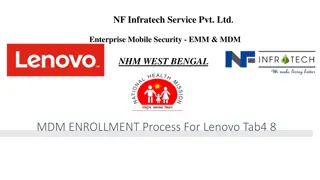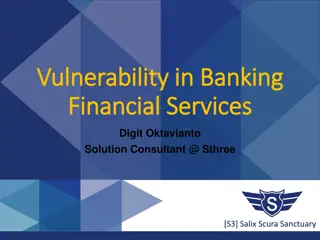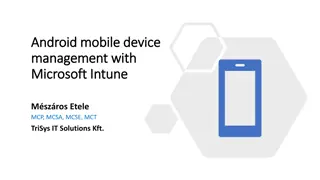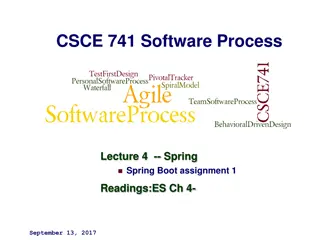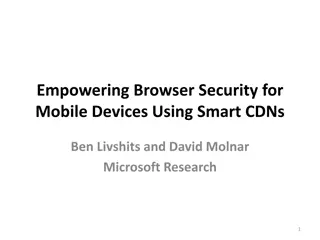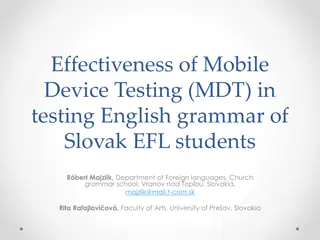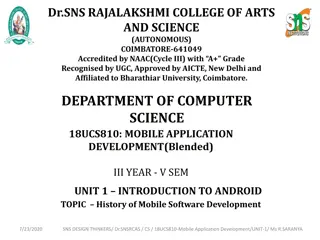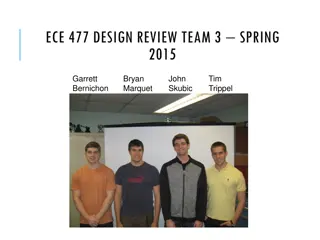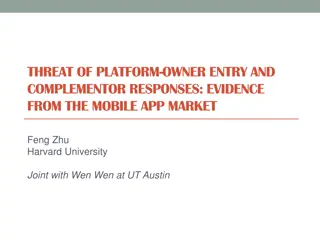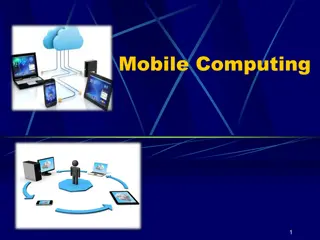Mobile Device and Platform Security in Spring 2017: Lecture Highlights
Explore the key topics covered in the Spring 2017 CS 155 course on Mobile Device and Platform Security, including guest lectures on container security by Diogo Mónica, Android history, platform trends, threat categories, defense mechanisms against theft, system architecture, Apple iOS and Android security features, app development, WebView security, and more.
Download Presentation

Please find below an Image/Link to download the presentation.
The content on the website is provided AS IS for your information and personal use only. It may not be sold, licensed, or shared on other websites without obtaining consent from the author.If you encounter any issues during the download, it is possible that the publisher has removed the file from their server.
You are allowed to download the files provided on this website for personal or commercial use, subject to the condition that they are used lawfully. All files are the property of their respective owners.
The content on the website is provided AS IS for your information and personal use only. It may not be sold, licensed, or shared on other websites without obtaining consent from the author.
E N D
Presentation Transcript
Spring 2017 CS 155 Mobile Device and Platform Security Part II John Mitchell
Guest Lecture Tuesday June 6 Diogo M nica, Director of security at Docker Topics include container security and what it is like working as a security engineer Diogo a very good speaker. Please show your appreciating and come to class. We will include topics on the final exam
Two lectures on mobile security Introduction: platforms and trends Threat categories Physical, platform malware, malicious apps Defense against physical theft Malware threats System architecture and defenses Apple iOS security features and app security model Android security features and app security model Security app development WebView secure app and web interface dev Device fragmentation Tues Thurs
ANDROID History and early decisions
Android history Android, Inc founded by Andy Rubin around 2005 Worked with HTC-built device with a physical keyboard Scrapped Blackberry-like phone when iPhone came out First Android phone HTC Dream, Oct 2008 (T-Mobile G1): touchscreen and keyboard Open-source software project Backed and acquired by Google
HTC Dream First phone had Android 1.6 (Donut) 3.15 megapixel rear camera with auto-focus 3.2 inch touchscreen Gmail, Google Maps, Search, Google Talk, You Tube, calendar, contacts, alarm
Android ecosystem Open-source software distributed by Google Increase number of users and devices linked to core Google products Multiple hardware vendors Can customize software for their products Open marketplace for apps
App market Self-signed apps App permissions granted on user installation Open market Bad apps may show up on market Shifts focus from remote exploit to privilege escalation
ANDROID PLATFORM Device locking and permissions
Device lock and unlock Similar PIN and fingerprint Fingerprint API lets users Unlock device Securely sign in to apps Use Android Pay Purchase on Play Store
Android permissions Example of permissions provided by Android android.permission.INTERNET android.permission.READ_EXTERNAL_STORAGE android.permission.SEND_SMS android.permission.BLUETOOTH Also possible to define custom permissions
Android permission model https://www.owasp.org/images/3/3e/Danelon_OWASP_EU_Tour_2013.pdf
ANDROID PLATFORM Platform security features
Android Platform outline: Linux kernel, browser, SQL-lite database Software for secure network communication Open SSL, Bouncy Castle crypto API and Java library C language infrastructure Java platform for running applications Dalvik bytecode, virtual machine
Exploit prevention Open source: public review, no obscurity Goals Prevent remote attacks, privilege escalation Secure drivers, media codecs, new and custom features Overflow prevention ProPolice stack protection First on the ARM architecture Some heap overflow protections Chunk consolidation in DL malloc (from OpenBSD) ASLR Avoided in initial release Many pre-linked images for performance Later developed and contributed by Bojinov, Boneh
dlmalloc (Doug Lea) Stores meta data in band Heap consolidation attack Heap overflow can overwrite pointers to previous and next unconsolidated chunks Overwriting these pointers allows remote code execution Change to improve security Check integrity of forward and backward pointers Simply check that back-forward-back = back, f-b-f=f Increases the difficulty of heap overflow
ANDROID PLATFORM App execution environment
Application development concepts Activity one-user task Example: scroll through your inbox Email client comprises many activities Service Java daemon that runs in background Example: application that streams an mp3 in background Intents asynchronous messaging system Fire an intent to switch from one activity to another Example: email app has inbox, compose activity, viewer activity User click on inbox entry fires an intent to the viewer activity, which then allows user to view that email Content provider Store and share data using a relational database interface Broadcast receiver mailboxes for messages from other applications
Security Features Isolation Multi-user Linux operating system Each application normally runs as a different user Communication between applications May share same Linux user ID Access files from each other May share same Linux process and Dalvik VM Communicate through application framework Intents, based on Binder, discussed in a few slides Battery life Developers must conserve power Applications store state so they can be stopped (to save power) and restarted helps with DoS
Application sandbox Application sandbox Each application runs with its UID in its own Dalvik virtual machine Provides CPU protection, memory protection Authenticated communication protection using Unix domain sockets Only ping, zygote (spawn another process) run as root Applications announce permission requirement Create a whitelist model user grants access Don t interrupt user all questions asked as install time Inter-component communication reference monitor checks permissions
Android permission model https://www.owasp.org/images/3/3e/Danelon_OWASP_EU_Tour_2013.pdf
Android Intents Msg between components in same or different app Intent is a bundle of information, e.g., action to be taken data to act on category of component to handle the intent instructions on how to launch a target activity Routing can be Explicit: delivered only to a specific receiver Implicit: all components that have registered to receive that action will get the message
Layers of security Each application executes as its own user identity Android middleware has reference monitor that mediates the establishment of inter-component communication (ICC) Source: Penn State group Android security paper
Security issues with intents Sender of an intent can verify that the recipient has a permission by specifying a permission with the method call Senders can use explicit intents to send the message to a single component (avoiding broadcasting) Receivers have to handle malicious intents
Attack: Permission redelegation Definition: an application without a permission gains additional privileges through another application Example of the confused deputy problem
Permission redelegation https://www.owasp.org/images/3/3e/Danelon_OWASP_EU_Tour_2013.pdf
Permission redelegation https://www.owasp.org/images/3/3e/Danelon_OWASP_EU_Tour_2013.pdf
How could this happen? App w/ permissions exposes a public interface Study in 2011 Examine 872 apps 320 of these (37%) have permissions and at least one type of public component Construct attacks using 15 vulnerabilities in 5 apps Reference Permission Re-Delegation: Attacks and Defenses, Adrienne Felt, Helen Wang, Alexander Moshchuk, Steven Hanna, Erika Chin, Usenix 2011
Example: power control widget Default widgets provided by Android, present on all devices Can change Wi-fi, BT, GPS, Data Sync, Screen Brightness with only one click Uses Intent to communicate the event of switching settings A malicious app without permissions can send a fake Intent to the Power Control Widget, simulating click to switch settings https://www.owasp.org/images/3/3e/Danelon_OWASP_EU_Tour_2013.pdf
Vulnerable versions (in red) Principle of least privilege helps but is not a solution Apps with permissions need to manage security https://www.owasp.org/images/3/3e/Danelon_OWASP_EU_Tour_2013.pdf
Java Sandbox Four complementary mechanisms Class loader Separate namespaces for separate class loaders Associates protection domain with each class Verifier and JVM run-time tests NO unchecked casts or other type errors, NO array overflow Preserves private, protected visibility levels Security Manager Called by library functions to decide if request is allowed Uses protection domain associated with code, user policy
Stack Inspection Permission depends on Permission of calling method Permission of all methods above it on stack Up to method that is trusted and asserts this trust method f method g method h java.io.FileInputStream Stories: Netscape font / passwd bug; Shockwave plug-in Many details omitted here
Malware behavior triggered by C&C server (Chuli)
A Large-Scale Study of Mobile Web App Security Patrick Mutchler, Adam Doupe, John Mitchell, Chris Kruegel, Giovanni Vigna
Mobile Web Apps Mobile web app: embeds a fully functional web browser as a UI element
JavaScript Bridge Obj foo = new Object(); addJavascriptInterface(foo, f ); Java JavaScript
JavaScript Bridge f.bar(); Java JavaScript
Security Concerns Who can access the bridge? Everyone
